
Question Number 16140 by b.e.h.i.8.3.4.1.7@gmail.com last updated on 18/Jun/17

Answered by ajfour last updated on 18/Jun/17

$${Area}_{\Delta{ABC}} \:=\:\frac{\mathrm{1}}{\sqrt{\mathrm{3}}}\left({a}^{\mathrm{2}} +{ab}+{b}^{\mathrm{2}} \right)\: \\ $$
Commented by b.e.h.i.8.3.4.1.7@gmail.com last updated on 18/Jun/17

$${thank}\:{you}\:{so}\:{much}\:{mr}\:{Ajfour}.{nice} \\ $$$${method}.{i}\:{love}\:{it}. \\ $$$${can}\:{we}\:{use}\:{this}\:{solution}\:{for}\:{Q}.\mathrm{15969}? \\ $$
Commented by ajfour last updated on 18/Jun/17

Commented by ajfour last updated on 18/Jun/17
![ssin θ = a ssin ((π/3)−θ) = b s(((√3)/2)cos θ−(1/2)sin θ) = b (√3)scos θ−ssin θ = 2b (√3)(√(s^2 −a^2 )) = a+2b 3(s^2 −a^2 ) = (a+2b)^2 s^2 = a^2 +(((a+2b)^2 )/3) A = ((√3)/4)[a^2 +(((a+2b)^2 )/3) ] = (1/(4(√3))) (4a^2 +4b^2 +4ab) = (1/(√3))(a^2 +ab+b^2 ) .](Q16145.png)
$$\:\:\:{s}\mathrm{sin}\:\theta\:=\:{a} \\ $$$$\:\:\:{s}\mathrm{sin}\:\left(\frac{\pi}{\mathrm{3}}−\theta\right)\:=\:{b} \\ $$$$\:\:\:{s}\left(\frac{\sqrt{\mathrm{3}}}{\mathrm{2}}\mathrm{cos}\:\theta−\frac{\mathrm{1}}{\mathrm{2}}\mathrm{sin}\:\theta\right)\:=\:{b} \\ $$$$\:\:\:\sqrt{\mathrm{3}}{s}\mathrm{cos}\:\theta−{s}\mathrm{sin}\:\theta\:=\:\mathrm{2}{b} \\ $$$$\:\:\:\sqrt{\mathrm{3}}\sqrt{{s}^{\mathrm{2}} −{a}^{\mathrm{2}} }\:=\:{a}+\mathrm{2}{b} \\ $$$$\:\:\:\mathrm{3}\left({s}^{\mathrm{2}} −{a}^{\mathrm{2}} \right)\:=\:\left({a}+\mathrm{2}{b}\right)^{\mathrm{2}} \\ $$$$\:\:\:\:\:\:\:\:\:\:\:\:\:{s}^{\mathrm{2}} \:=\:{a}^{\mathrm{2}} +\frac{\left({a}+\mathrm{2}{b}\right)^{\mathrm{2}} }{\mathrm{3}} \\ $$$$\:\:\:{A}\:=\:\frac{\sqrt{\mathrm{3}}}{\mathrm{4}}\left[{a}^{\mathrm{2}} +\frac{\left({a}+\mathrm{2}{b}\right)^{\mathrm{2}} }{\mathrm{3}}\:\right] \\ $$$$\:\:\:\:\:\:\:=\:\frac{\mathrm{1}}{\mathrm{4}\sqrt{\mathrm{3}}}\:\left(\mathrm{4}{a}^{\mathrm{2}} +\mathrm{4}{b}^{\mathrm{2}} +\mathrm{4}{ab}\right) \\ $$$$\:\:\:\:\:\:=\:\frac{\mathrm{1}}{\sqrt{\mathrm{3}}}\left({a}^{\mathrm{2}} +{ab}+{b}^{\mathrm{2}} \right)\:. \\ $$
Answered by mrW1 last updated on 18/Jun/17
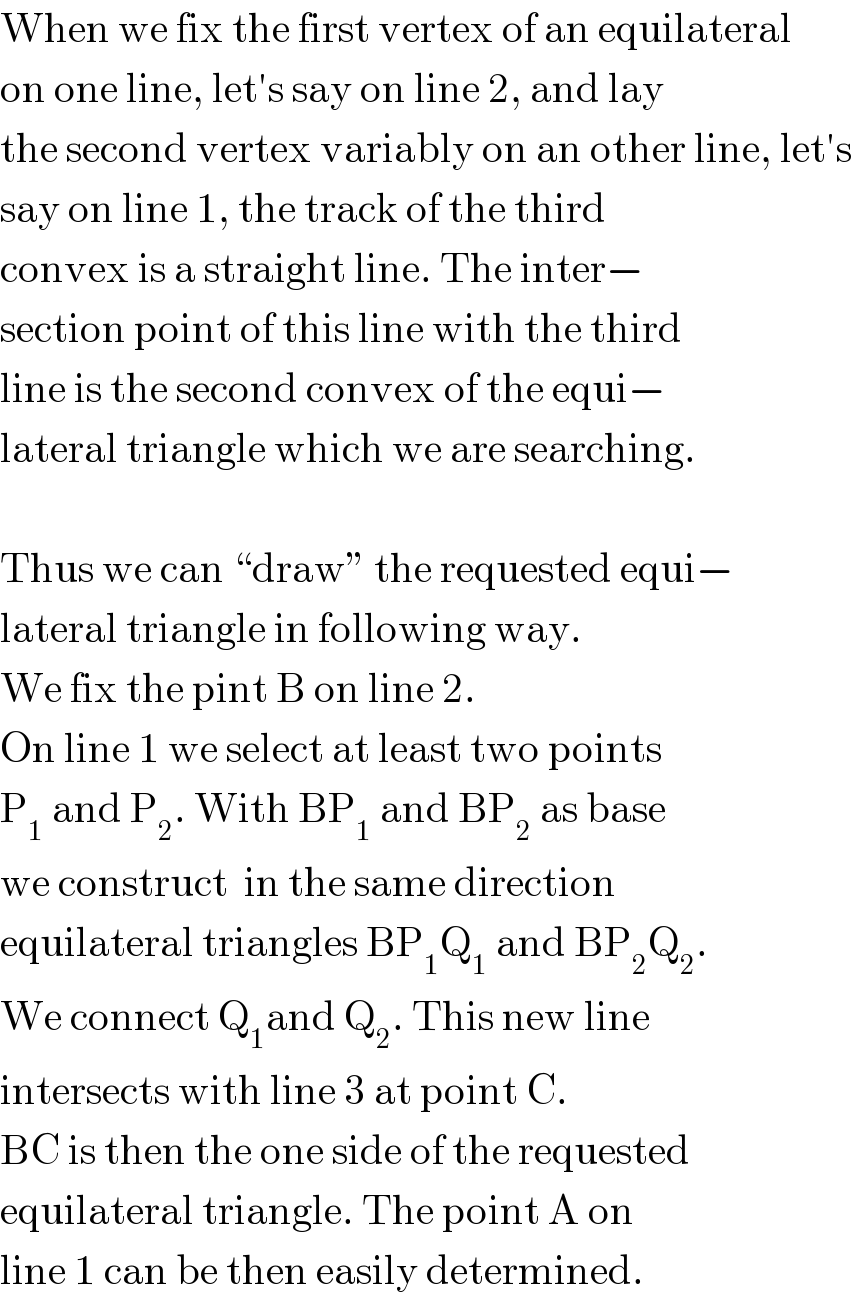
$$\mathrm{When}\:\mathrm{we}\:\mathrm{fix}\:\mathrm{the}\:\mathrm{first}\:\mathrm{vertex}\:\mathrm{of}\:\mathrm{an}\:\mathrm{equilateral} \\ $$$$\mathrm{on}\:\mathrm{one}\:\mathrm{line},\:\mathrm{let}'\mathrm{s}\:\mathrm{say}\:\mathrm{on}\:\mathrm{line}\:\mathrm{2},\:\mathrm{and}\:\mathrm{lay} \\ $$$$\mathrm{the}\:\mathrm{second}\:\mathrm{vertex}\:\mathrm{variably}\:\mathrm{on}\:\mathrm{an}\:\mathrm{other}\:\mathrm{line},\:\mathrm{let}'\mathrm{s} \\ $$$$\mathrm{say}\:\mathrm{on}\:\mathrm{line}\:\mathrm{1},\:\mathrm{the}\:\mathrm{track}\:\mathrm{of}\:\mathrm{the}\:\mathrm{third}\: \\ $$$$\mathrm{convex}\:\mathrm{is}\:\mathrm{a}\:\mathrm{straight}\:\mathrm{line}.\:\mathrm{The}\:\mathrm{inter}− \\ $$$$\mathrm{section}\:\mathrm{point}\:\mathrm{of}\:\mathrm{this}\:\mathrm{line}\:\mathrm{with}\:\mathrm{the}\:\mathrm{third} \\ $$$$\mathrm{line}\:\mathrm{is}\:\mathrm{the}\:\mathrm{second}\:\mathrm{convex}\:\mathrm{of}\:\mathrm{the}\:\mathrm{equi}− \\ $$$$\mathrm{lateral}\:\mathrm{triangle}\:\mathrm{which}\:\mathrm{we}\:\mathrm{are}\:\mathrm{searching}. \\ $$$$ \\ $$$$\mathrm{Thus}\:\mathrm{we}\:\mathrm{can}\:``\mathrm{draw}''\:\mathrm{the}\:\mathrm{requested}\:\mathrm{equi}− \\ $$$$\mathrm{lateral}\:\mathrm{triangle}\:\mathrm{in}\:\mathrm{following}\:\mathrm{way}. \\ $$$$\mathrm{We}\:\mathrm{fix}\:\mathrm{the}\:\mathrm{pint}\:\mathrm{B}\:\mathrm{on}\:\mathrm{line}\:\mathrm{2}. \\ $$$$\mathrm{On}\:\mathrm{line}\:\mathrm{1}\:\mathrm{we}\:\mathrm{select}\:\mathrm{at}\:\mathrm{least}\:\mathrm{two}\:\mathrm{points} \\ $$$$\mathrm{P}_{\mathrm{1}} \:\mathrm{and}\:\mathrm{P}_{\mathrm{2}} .\:\mathrm{With}\:\mathrm{BP}_{\mathrm{1}} \:\mathrm{and}\:\mathrm{BP}_{\mathrm{2}} \:\mathrm{as}\:\mathrm{base} \\ $$$$\mathrm{we}\:\mathrm{construct}\:\:\mathrm{in}\:\mathrm{the}\:\mathrm{same}\:\mathrm{direction} \\ $$$$\mathrm{equilateral}\:\mathrm{triangles}\:\mathrm{BP}_{\mathrm{1}} \mathrm{Q}_{\mathrm{1}} \:\mathrm{and}\:\mathrm{BP}_{\mathrm{2}} \mathrm{Q}_{\mathrm{2}} . \\ $$$$\mathrm{We}\:\mathrm{connect}\:\mathrm{Q}_{\mathrm{1}} \mathrm{and}\:\mathrm{Q}_{\mathrm{2}} .\:\mathrm{This}\:\mathrm{new}\:\mathrm{line} \\ $$$$\mathrm{intersects}\:\mathrm{with}\:\mathrm{line}\:\mathrm{3}\:\mathrm{at}\:\mathrm{point}\:\mathrm{C}. \\ $$$$\mathrm{BC}\:\mathrm{is}\:\mathrm{then}\:\mathrm{the}\:\mathrm{one}\:\mathrm{side}\:\mathrm{of}\:\mathrm{the}\:\mathrm{requested} \\ $$$$\mathrm{equilateral}\:\mathrm{triangle}.\:\mathrm{The}\:\mathrm{point}\:\mathrm{A}\:\mathrm{on} \\ $$$$\mathrm{line}\:\mathrm{1}\:\mathrm{can}\:\mathrm{be}\:\mathrm{then}\:\mathrm{easily}\:\mathrm{determined}. \\ $$
Commented by mrW1 last updated on 18/Jun/17

Commented by mrW1 last updated on 18/Jun/17
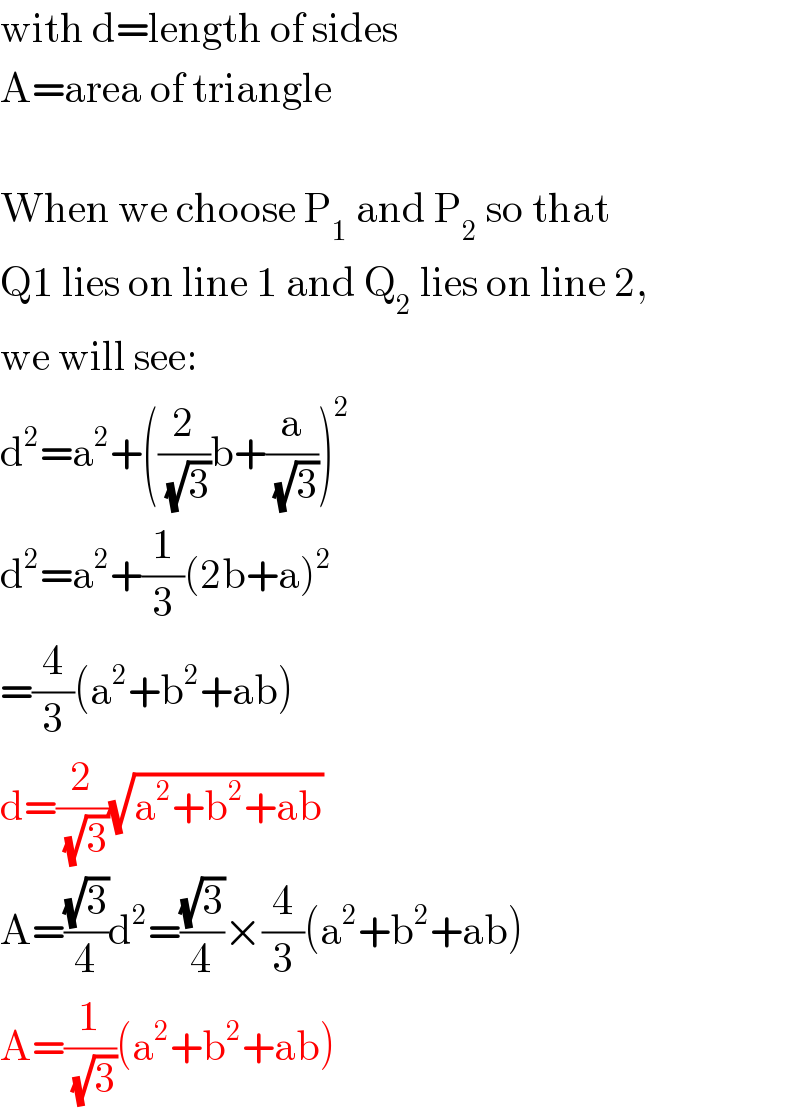
$$\mathrm{with}\:\mathrm{d}=\mathrm{length}\:\mathrm{of}\:\mathrm{sides} \\ $$$$\mathrm{A}=\mathrm{area}\:\mathrm{of}\:\mathrm{triangle} \\ $$$$ \\ $$$$\mathrm{When}\:\mathrm{we}\:\mathrm{choose}\:\mathrm{P}_{\mathrm{1}} \:\mathrm{and}\:\mathrm{P}_{\mathrm{2}} \:\mathrm{so}\:\mathrm{that} \\ $$$$\mathrm{Q1}\:\mathrm{lies}\:\mathrm{on}\:\mathrm{line}\:\mathrm{1}\:\mathrm{and}\:\mathrm{Q}_{\mathrm{2}} \:\mathrm{lies}\:\mathrm{on}\:\mathrm{line}\:\mathrm{2}, \\ $$$$\mathrm{we}\:\mathrm{will}\:\mathrm{see}: \\ $$$$\mathrm{d}^{\mathrm{2}} =\mathrm{a}^{\mathrm{2}} +\left(\frac{\mathrm{2}}{\sqrt{\mathrm{3}}}\mathrm{b}+\frac{\mathrm{a}}{\sqrt{\mathrm{3}}}\right)^{\mathrm{2}} \\ $$$$\mathrm{d}^{\mathrm{2}} =\mathrm{a}^{\mathrm{2}} +\frac{\mathrm{1}}{\mathrm{3}}\left(\mathrm{2b}+\mathrm{a}\right)^{\mathrm{2}} \\ $$$$=\frac{\mathrm{4}}{\mathrm{3}}\left(\mathrm{a}^{\mathrm{2}} +\mathrm{b}^{\mathrm{2}} +\mathrm{ab}\right) \\ $$$$\mathrm{d}=\frac{\mathrm{2}}{\sqrt{\mathrm{3}}}\sqrt{\mathrm{a}^{\mathrm{2}} +\mathrm{b}^{\mathrm{2}} +\mathrm{ab}} \\ $$$$\mathrm{A}=\frac{\sqrt{\mathrm{3}}}{\mathrm{4}}\mathrm{d}^{\mathrm{2}} =\frac{\sqrt{\mathrm{3}}}{\mathrm{4}}×\frac{\mathrm{4}}{\mathrm{3}}\left(\mathrm{a}^{\mathrm{2}} +\mathrm{b}^{\mathrm{2}} +\mathrm{ab}\right) \\ $$$$\mathrm{A}=\frac{\mathrm{1}}{\sqrt{\mathrm{3}}}\left(\mathrm{a}^{\mathrm{2}} +\mathrm{b}^{\mathrm{2}} +\mathrm{ab}\right) \\ $$
Commented by RasheedSoomro last updated on 18/Jun/17

$$\mathrm{MrW1},\mathrm{Mr}\:\mathrm{ajfour}\:\&\:\mathrm{Mr}\:\mathrm{Abu}\:\mathrm{Behi}. \\ $$$$\mathrm{What}\:\mathrm{a}\:\mathrm{depth}\:\mathrm{in}\:\mathrm{geometry}\:\mathrm{you}\:\mathrm{have}!! \\ $$
Commented by mrW1 last updated on 18/Jun/17

$$\mathrm{Thank}\:\mathrm{you}\:\mathrm{sir}!\:\mathrm{Geometry}\:\mathrm{has}\:\:\mathrm{always} \\ $$$$\mathrm{been}\:\mathrm{my}\:\mathrm{favorite}\:\mathrm{subject}. \\ $$
Commented by b.e.h.i.8.3.4.1.7@gmail.com last updated on 18/Jun/17
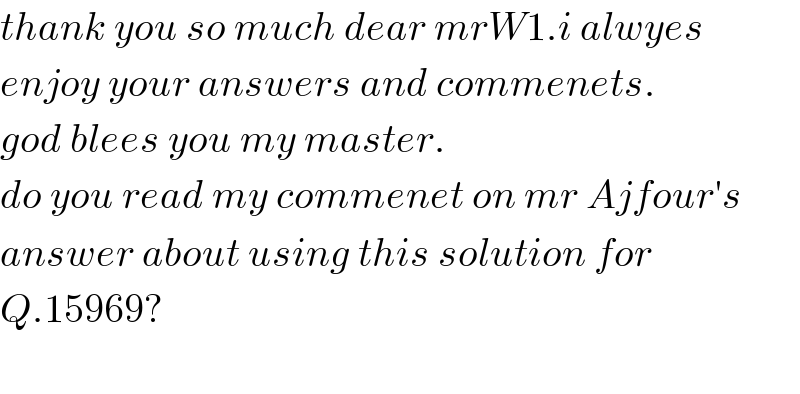
$${thank}\:{you}\:{so}\:{much}\:{dear}\:{mrW}\mathrm{1}.{i}\:{alwyes} \\ $$$${enjoy}\:{your}\:{answers}\:{and}\:{commenets}. \\ $$$${god}\:{blees}\:{you}\:{my}\:{master}. \\ $$$${do}\:{you}\:{read}\:{my}\:{commenet}\:{on}\:{mr}\:{Ajfour}'{s} \\ $$$${answer}\:{about}\:{using}\:{this}\:{solution}\:{for} \\ $$$${Q}.\mathrm{15969}? \\ $$$$ \\ $$
Commented by b.e.h.i.8.3.4.1.7@gmail.com last updated on 18/Jun/17

$${thank}\:{you}\:{mr}\:{Rasheed}.{my}\:{name}\:{is}:{amir}. \\ $$$${no}\:{one}\:{called}\:{me}\:{as}:{Abu}\:{behi}\:{yet}.\left({hahaha}\right) \\ $$
Commented by mrW1 last updated on 18/Jun/17
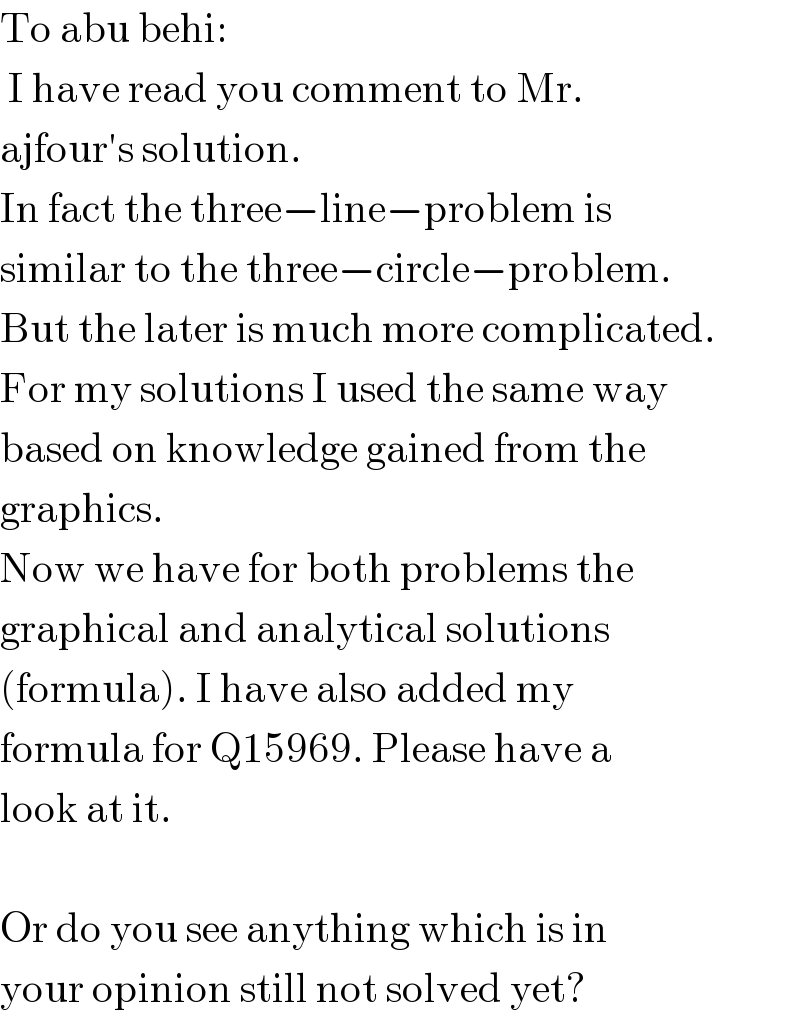
$$\mathrm{To}\:\mathrm{abu}\:\mathrm{behi}: \\ $$$$\:\mathrm{I}\:\mathrm{have}\:\mathrm{read}\:\mathrm{you}\:\mathrm{comment}\:\mathrm{to}\:\mathrm{Mr}. \\ $$$$\mathrm{ajfour}'\mathrm{s}\:\mathrm{solution}. \\ $$$$\mathrm{In}\:\mathrm{fact}\:\mathrm{the}\:\mathrm{three}−\mathrm{line}−\mathrm{problem}\:\mathrm{is} \\ $$$$\mathrm{similar}\:\mathrm{to}\:\mathrm{the}\:\mathrm{three}−\mathrm{circle}−\mathrm{problem}. \\ $$$$\mathrm{But}\:\mathrm{the}\:\mathrm{later}\:\mathrm{is}\:\mathrm{much}\:\mathrm{more}\:\mathrm{complicated}. \\ $$$$\mathrm{For}\:\mathrm{my}\:\mathrm{solutions}\:\mathrm{I}\:\mathrm{used}\:\mathrm{the}\:\mathrm{same}\:\mathrm{way} \\ $$$$\mathrm{based}\:\mathrm{on}\:\mathrm{knowledge}\:\mathrm{gained}\:\mathrm{from}\:\mathrm{the} \\ $$$$\mathrm{graphics}. \\ $$$$\mathrm{Now}\:\mathrm{we}\:\mathrm{have}\:\mathrm{for}\:\mathrm{both}\:\mathrm{problems}\:\mathrm{the} \\ $$$$\mathrm{graphical}\:\mathrm{and}\:\mathrm{analytical}\:\mathrm{solutions}\: \\ $$$$\left(\mathrm{formula}\right).\:\mathrm{I}\:\mathrm{have}\:\mathrm{also}\:\mathrm{added}\:\mathrm{my} \\ $$$$\mathrm{formula}\:\mathrm{for}\:\mathrm{Q15969}.\:\mathrm{Please}\:\mathrm{have}\:\mathrm{a} \\ $$$$\mathrm{look}\:\mathrm{at}\:\mathrm{it}. \\ $$$$ \\ $$$$\mathrm{Or}\:\mathrm{do}\:\mathrm{you}\:\mathrm{see}\:\mathrm{anything}\:\mathrm{which}\:\mathrm{is}\:\mathrm{in} \\ $$$$\mathrm{your}\:\mathrm{opinion}\:\mathrm{still}\:\mathrm{not}\:\mathrm{solved}\:\mathrm{yet}? \\ $$
Commented by b.e.h.i.8.3.4.1.7@gmail.com last updated on 18/Jun/17
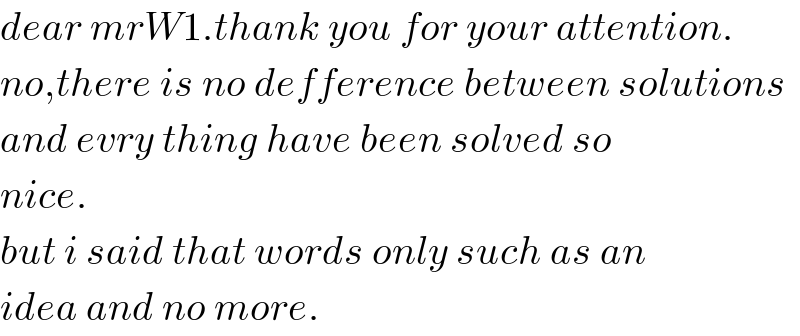
$${dear}\:{mrW}\mathrm{1}.{thank}\:{you}\:{for}\:{your}\:{attention}. \\ $$$${no},{there}\:{is}\:{no}\:{defference}\:{between}\:{solutions} \\ $$$${and}\:{evry}\:{thing}\:{have}\:{been}\:{solved}\:{so} \\ $$$${nice}. \\ $$$${but}\:{i}\:{said}\:{that}\:{words}\:{only}\:{such}\:{as}\:{an} \\ $$$${idea}\:{and}\:{no}\:{more}. \\ $$
Commented by mrW1 last updated on 18/Jun/17

$$\mathrm{Thank}\:\mathrm{you}\:\mathrm{for}\:\mathrm{all}\:\mathrm{these}\:\mathrm{interesting} \\ $$$$\mathrm{geometry}\:\mathrm{questions}. \\ $$
